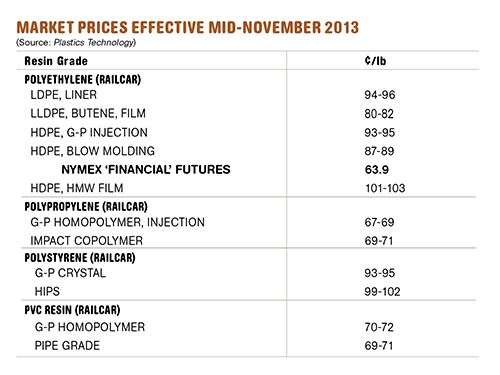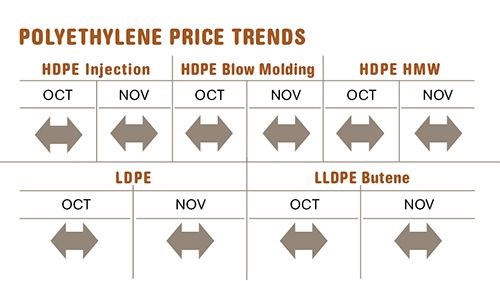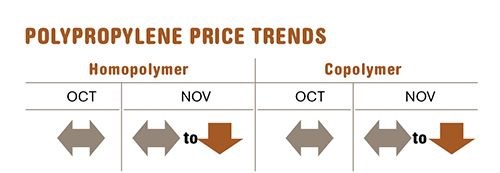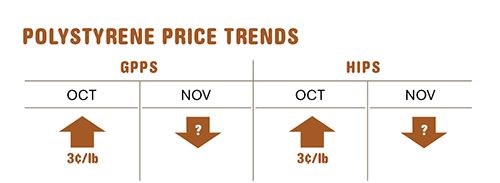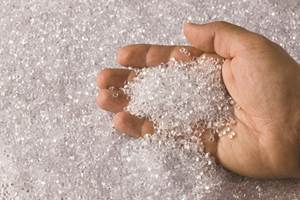Mid November Commodity Resin Prices Flat to Soft
Prices of the four major commodity thermoplastics are projected to be a bit lower or remain flat (especially in the case of PE) as the year comes to an end.
Prices of the four major commodity thermoplastics are projected to be a bit lower or remain flat (especially in the case of PE) as the year comes to an end. Slowed seasonal demand, relatively tight to balanced supplier inventories, and lower feedstock costs are key driving factors. That’s the view of resin purchasing consultants at Resin Technology, Inc. (RTi) Fort Worth, Texas, and Michael Greenberg of The Plastics Exchange, Chicago.
PE PRICES FLAT
Polyethylene prices were flat through October and into November. This was the first such period this year that no industrywide price hikes were on the table, according to Mike Burns, RTi’s v.p. for PE. In early November, The Plastics Exchange’s Greenberg speculated that a little relief was possible for November PE contracts, noting that “there is plenty of margin to be shared on both a spot and contract basis.” He noted that processors were seeking a price decrease and were drawing down their resin supplies for year-end inventory accounting. RTi’s Burns noted that resin availability, the driving factor behind PE resin price hikes this year, “appears to be improving,” with no product allocations over the last few months and the emergence of some export activity after a lengthy hiatus. “Off-grade resin prices have come down a bit, and there is more inventory and less panic about getting material,” he observed.
Still, Burns does not see PE contract resin prices dropping, noting that PE processors have been able to pass along this year’s resin price hikes to their end-use customers, and resin suppliers are quite cognizant of that. Processors will buy as needed through this month, regardless of any end-of-year price-increase announcements. Burns expects an increase to emerge in the first quarter of 2014.
PP PRICES FLAT OR LOWER
Polypropylene prices in November were likely to roll over or drop by 0.5 ¢ to 1¢/lb, depending on propylene monomer contract settlements. For this month, prices were projected to remain flat. Although there has been some scheduled downtime for propylene production facilities in the last couple of months, generally soft demand means that these temporary phenomena were not expected to result in higher monomer or polymer prices.
Having been tight for most of this year, PP supplies began to loosen up little by little as we entered the fourth quarter. Supplier inventories are reported to be building up, and plant operating rates dropped from the low-to-mid 90s to the mid-to-high 80s percentile by last month. After several months of premium prices, spot PP material dropped below prime resin cost. Says Scott Newell, RTI’s director of client services for PP, “Sellers initially held firm on price and there was no movement. As they started to lower prices a bit to generate some demand, there was little response until they lowered prices by 2-4¢/lb.” Greenberg reported spot prices dropping by up to 7¢/lb within the six weeks leading up to Nov. 1, a period in which there was a steady flow of well-priced off-grade material.
Demand for PP in the fourth quarter was expected to register an increase. Newell explains that this does not represent “real demand,” but indicates year-end railcar deals that producers offered to move product and which were snapped up by processors. “Historically, processors have seen price increases announced for the first part of a new year. But this is not necessarily going to be the case this time,” Newell notes.
PS PRICE ROLLBACK LIKELY
Polystyrene prices moved up 3¢/lb across the board in October, owing largely to planned and unplanned monomer and polymer production disruptions. By early November, however, a price drop of 2-3¢/lb looked very likely, according to Mark Kallman, RTi’s director of client services for engineering resins, PS, and PVC. Prospects of price relief before year’s end are bolstered by a drop of 27¢/gal in November benzene contract prices, along with the possibility of a 1¢/lb drop in ethylene prices for October contracts.
PVC PRICES FLAT TO DOWN
Vinyl resin prices dropped by 1¢/lb in October and were expected to be flat or down another penny last month. Two major planned PVC plant shutdowns were completed by last month and had no impact on the market due to the domestic seasonal slowdown, according to RTi's Kallman. Lower ethylene monomer contract prices would also point to slightly lower resin prices. However, there has been increased interest from export markets, which could tighten up domestic supply a bit.
Related Content
Fundamentals of Polyethylene – Part 5: Metallocenes
How the development of new catalysts—notably metallocenes—paved the way for the development of material grades never before possible.
Read MoreFundamentals of Polyethylene – Part 3: Field Failures
Polyethylene parts can fail when an inappropriate density is selected. Let’s look at some examples and examine what happened and why.
Read MoreFirst Quarter Looks Mostly Flat for Resin Prices
Temporary upward blips don't indicate any sustained movement in the near term.
Read MoreFungi Makes Meal of Polypropylene
University of Sydney researchers identify two strains of fungi that can biodegrade hard to recycle plastics like PP.
Read MoreRead Next
Beyond Prototypes: 8 Ways the Plastics Industry Is Using 3D Printing
Plastics processors are finding applications for 3D printing around the plant and across the supply chain. Here are 8 examples to look for at NPE2024.
Read MoreSee Recyclers Close the Loop on Trade Show Production Scrap at NPE2024
A collaboration between show organizer PLASTICS, recycler CPR and size reduction experts WEIMA and Conair recovered and recycled all production scrap at NPE2024.
Read More

